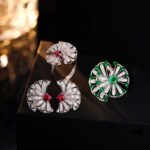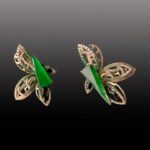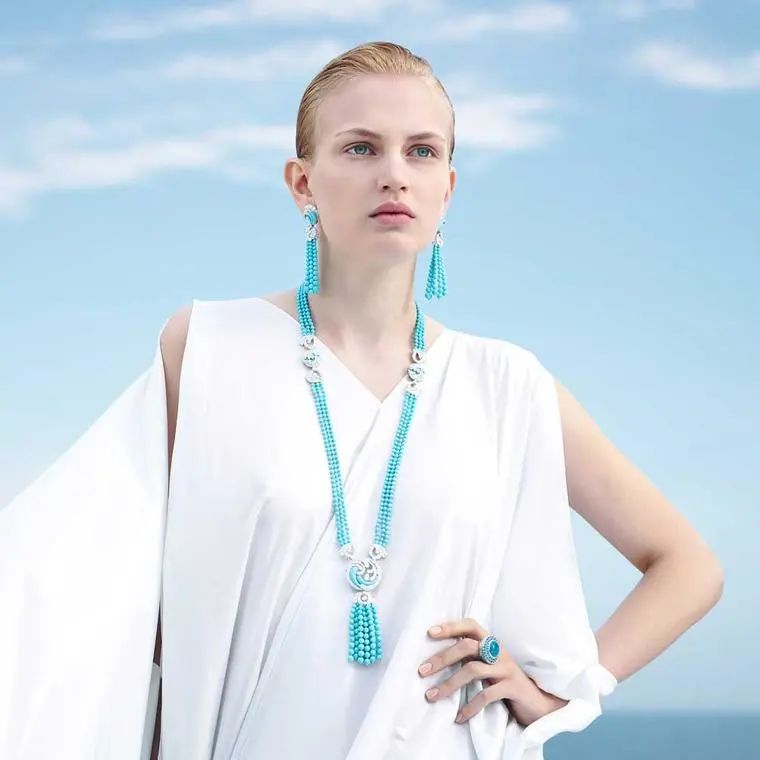
Turquoise is both ancient and trendy, with its unique color making it a favorite in the jewelry world across every era. However, this distinctive hue also makes it stand out, sometimes appearing out of place among other colored gemstones.
As a result, it disappeared from modern high jewelry for a long time. That is, until recent years when master jewelers found new ways to play with it, quietly bringing it back as a “regular” in the high jewelry circle!
As turquoise is a surface mineral, humans discovered its beauty very early on, making it a gemstone with a considerably long history. Both ancient Egypt and China used turquoise jewelry in their early civilizations, dating back to before the Common Era. Its vibrant color easily made it a symbol of nobility and power.

Ancient Egyptians were fascinated by turquoise, viewing it as a symbol of the goddess Hathor and believing it possessed the power of fertility and rebirth. As a result, pharaohs were buried with numerous jewels and objects inlaid with turquoise.
While it may not have succeeded in helping pharaohs to be reborn, turquoise itself “resurrected” quite easily. For instance, when the “revival trend” emerged in the 19th century, jewelry masters of the archaeological revival style brought turquoise and Egyptian style back to the center of the jewelry world, showcasing its vibrant vitality.
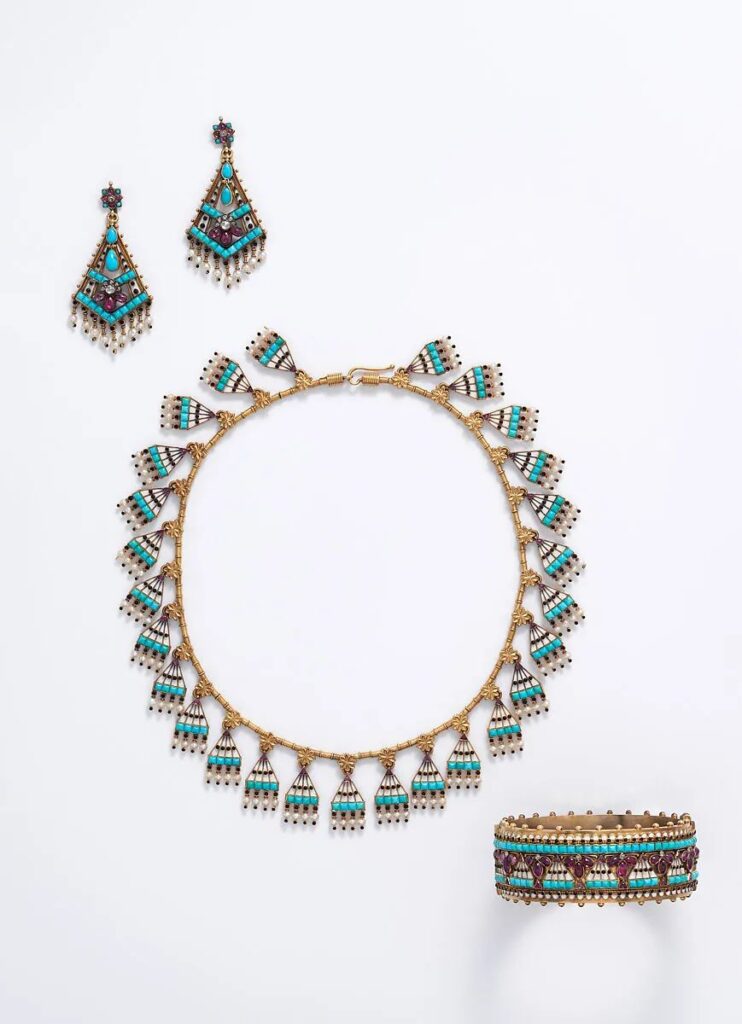
Egyptian Revival style set
Gold, turquoise, ruby, diamond, enamel, pearl
1865
China’s love for turquoise jewelry began as early as the Shang and Zhou dynasties. As seen in “Creation of the Gods Part One,” both King Zhou and Queen Jiang wore turquoise from head to toe.
Archaeological excavations have unearthed numerous turquoise jewels, from the Jiahu site in Wuyang dating back about 8,000 years to the Yangshao culture sites from about 6,500-4,400 years ago. By the Shang dynasty, remarkable artisans had already learned to inlay turquoise in figurative patterns, incorporating it into various objects.
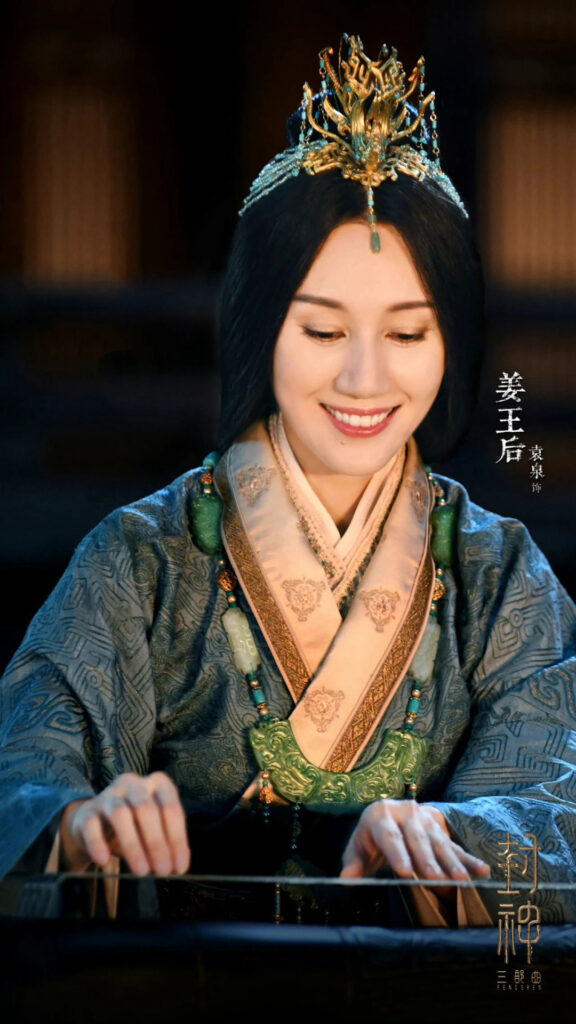
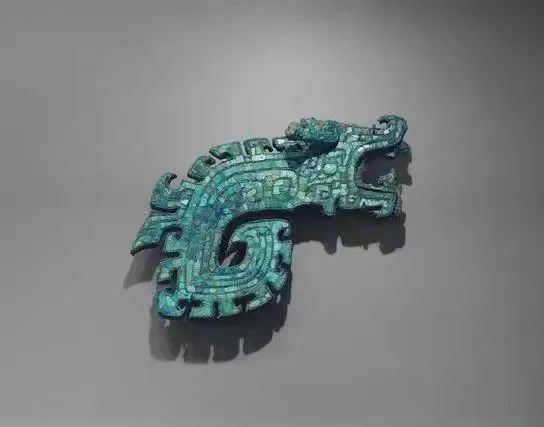
The turquoise craze in Europe began in the Mediterranean, with the Medici family of Italy wearing turquoise cameos to seek good fortune. Subsequently, royal families across Europe owned turquoise sets. The Russian Empress Alexandra Feodorovna possessed a turquoise tiara crafted by Fabergé, as Russians believed turquoise represented luck and could bring health and prosperity.

The British Royal Family also owned several turquoise parures. Queen Mary, being fond of turquoise, gifted sets to Queen Elizabeth and the Duchess of Gloucester when her sons married.
Queen Elizabeth’s turquoise jewelry was later inherited by Princess Margaret, but after the princess’s death, this set did not go to auction and is presumed to have returned to the royal jewelry collection, never to be seen in public again. Therefore, the set most commonly seen nowadays is the one worn by the current Duchess of Gloucester, Birgitte.
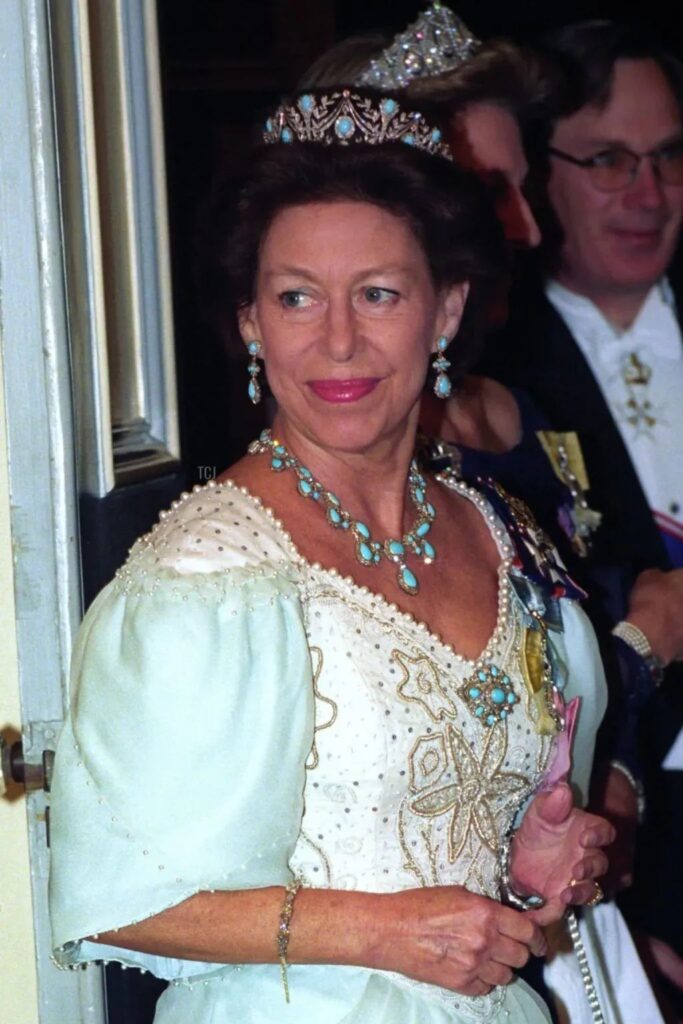
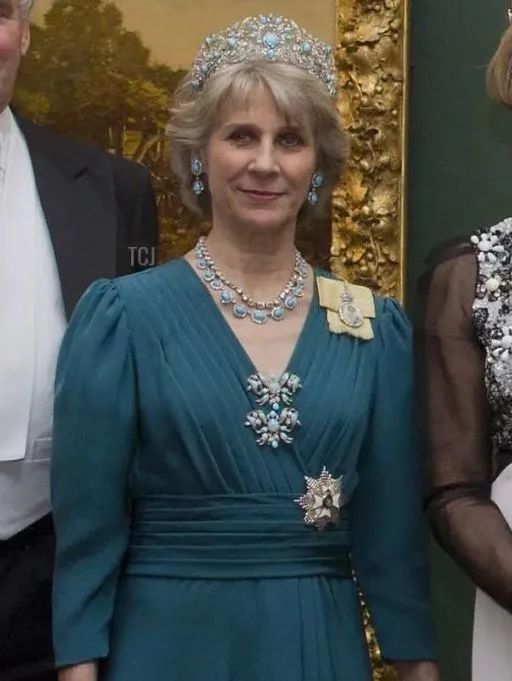
In recent years, turquoise has gained popularity in the high jewelry circle due to its unique soft and bright blue color. Of course, most major brands choose high-grade, matrix-free, high-porcelain blue turquoise. This gemstone, with a color similar to a “robin’s egg,” always manages to provide the perfect highlight for their creations.
Turquoise is a translucent to opaque gemstone, but most high jewelry pieces use opaque turquoise with very fine, uniform texture (high porcelain quality). Therefore, its charm lies in its bright color, and many brands strive to emphasize its wonderful blue hue in their designs. Common approaches include complementing shades of the same color, gradual progression from light to dark, focusing on harmony, and highlighting textural differences.

Circa 1900
For instance, Garrard, the official jeweler to the British Royal Family, previously created the aforementioned turquoise parure for Queen Mary. This year, Creative Director Sara Prentice launched the Couture high jewelry collection inspired by haute couture, aiming to innovate and showcase female power.
The Mystique set features turquoise, combining this delicate blue with two styles of aquamarine. This creates a poetic and romantic tone as the blue transitions from transparent to translucent to opaque, set against a backdrop of pavé diamonds to enhance the overall grandeur of the piece.
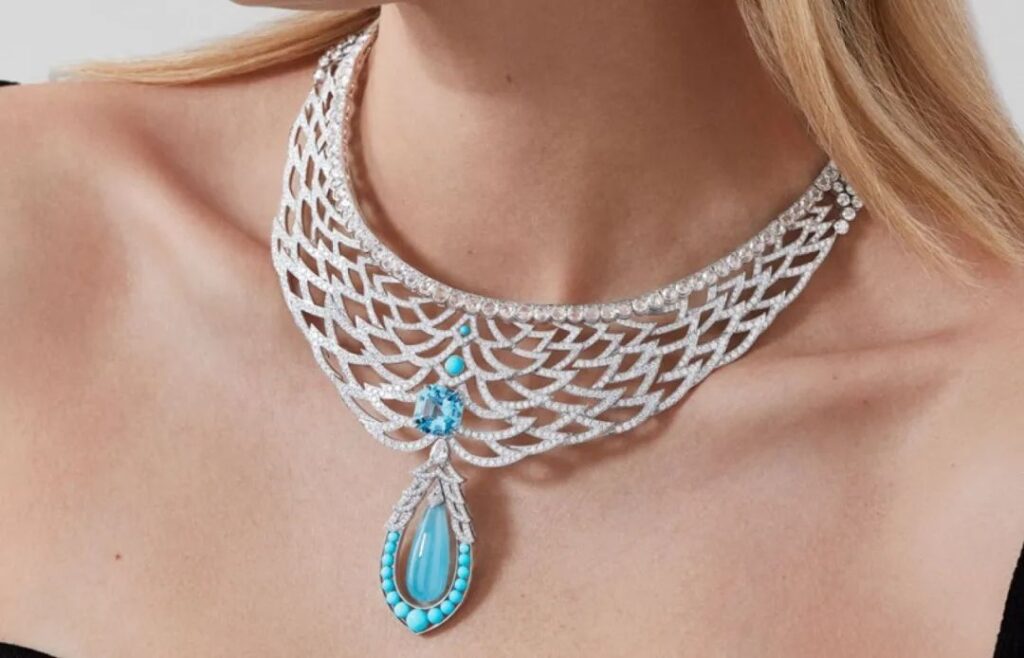
Couture High Jewelry Collection
Mystique Necklace
18K white gold, turquoise, aquamarine, diamonds
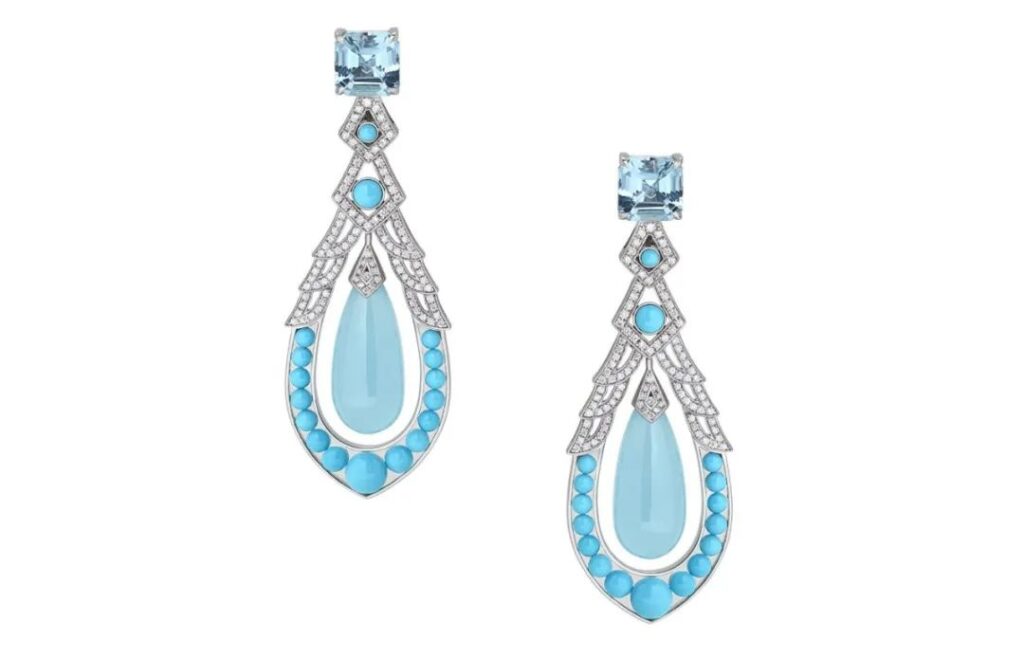
Couture High Jewelry Collection
Mystique Earrings
18K white gold, turquoise, aquamarine, diamonds
Pairing turquoise with white pearls and colorless diamonds is a foolproof technique that maximally accentuates the delicate blue of turquoise. This approach is often seen in jewelry where turquoise is the main stone.
Of course, nowadays, only major jewelry brands may have the resources and confidence to design such lavish pieces using turquoise, as high-quality turquoise has become increasingly rare over time.

Seven Seas High Jewelry Collection Necklace
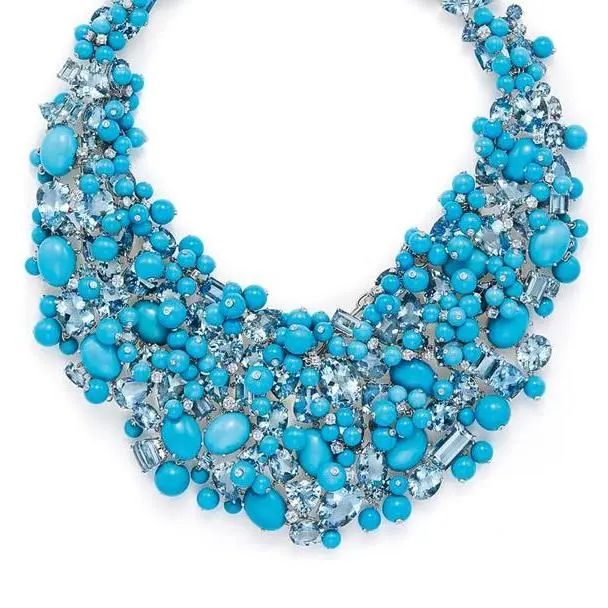
Blue Book High Jewelry Collection Necklace

Secrets and Lights Collection Necklace

Serpenti High Jewelry Necklace
A common approach in today’s high jewelry circle is to use contrasting color combinations to highlight the brilliance of turquoise. Harry Winston, for example, pairs turquoise with vibrant and sweet fanta stone, luscious pink tourmaline, and romantic and mysterious purple spinel to create visually striking combinations.
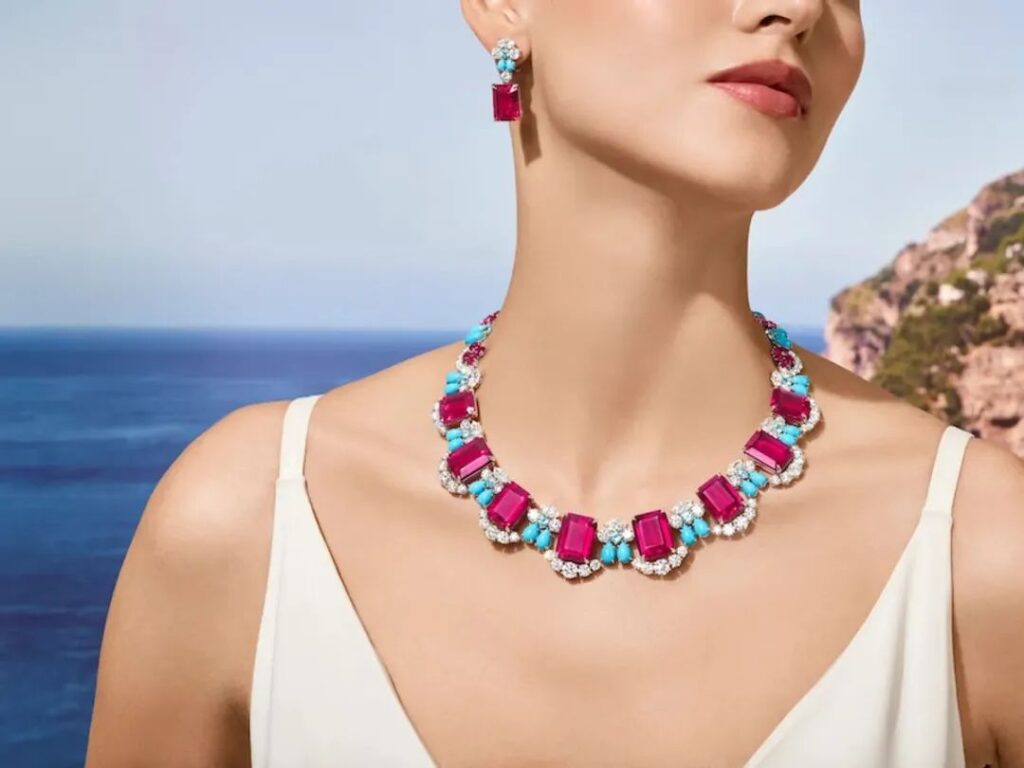
Majestic Escapes High Jewelry Collection
Bougainvillea Necklace
Turquoise, tourmaline, diamonds
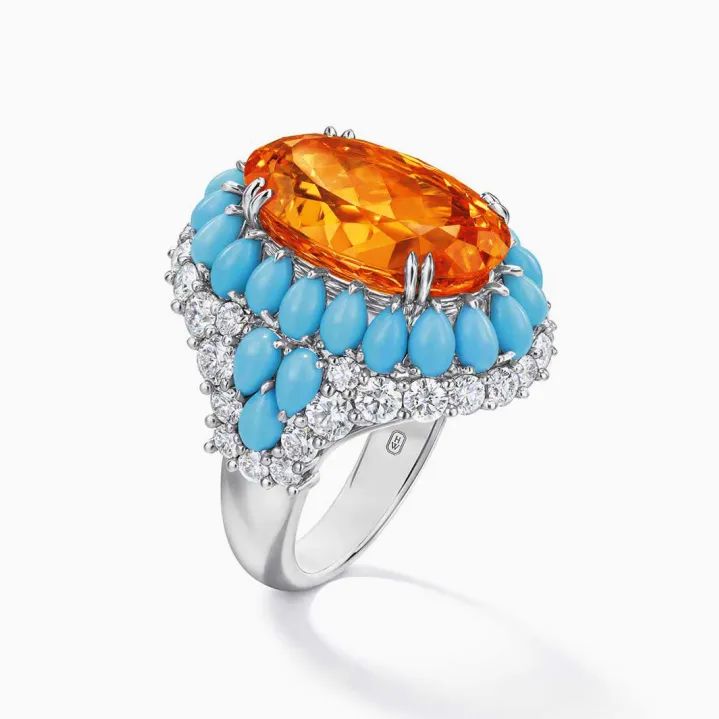
Candy High Jewelry Collection Ring
Turquoise, fanta stone, diamonds
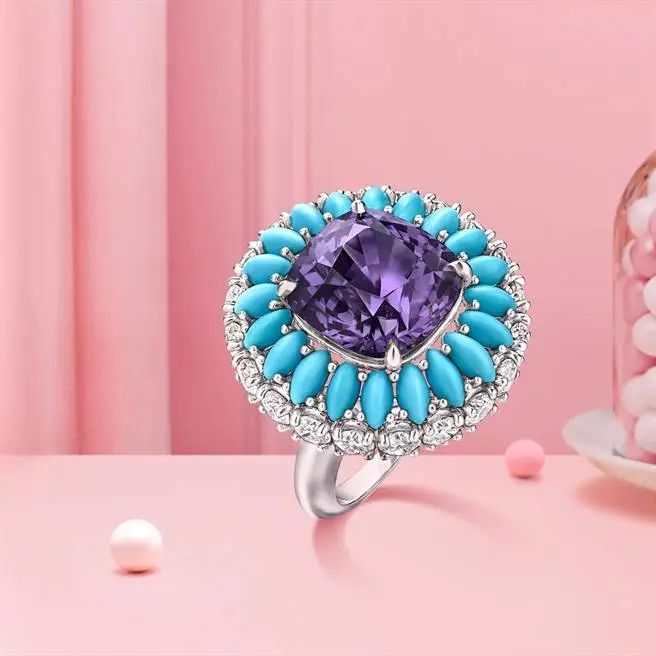
Candy High Jewelry Collection Ring
Turquoise, spinel, diamonds
Bulgari, a jewelry brand known for its mastery of color, naturally adores turquoise. For this brand, two colors are far from enough; only combinations of three or more colors qualify as “colored gemstone works.” Whether as the main stone or an accent, Bulgari can cut and shape these gems into any form to create a vibrant, colorful jewelry masterpiece.
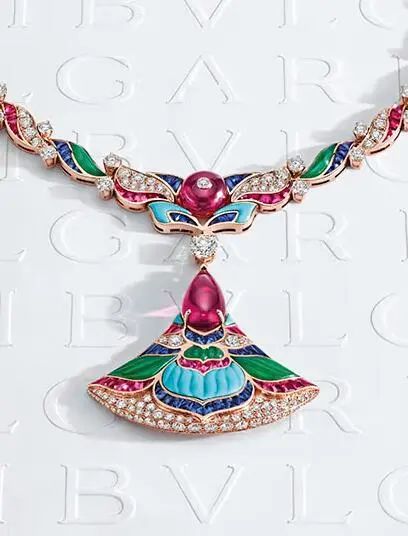
Mediterranea High Jewelry Collection
Oriental Mosaic Necklace
Sapphire, tourmaline, turquoise, green chalcedony, diamonds
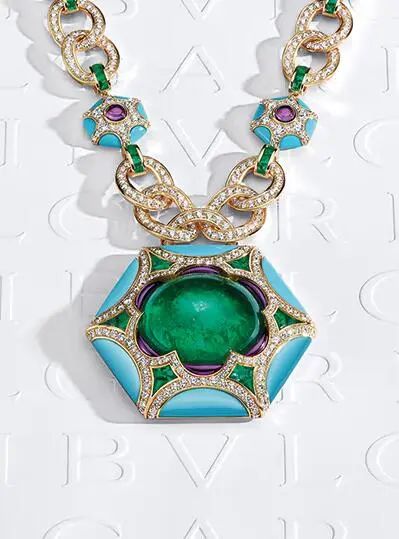
Mediterranea High Jewelry Collection
Roman Esedra Necklace
Emerald, amethyst, turquoise, enamel, diamonds
Some niche brands also have their unique methods of showcasing turquoise’s distinctive vivid hue. For instance, de Grisogono has its own interpretation of turquoise. While also employing contrasting colors, it chooses to pair deeper-toned amethyst with lighter turquoise, creating contrast not only in hue but also in brightness.
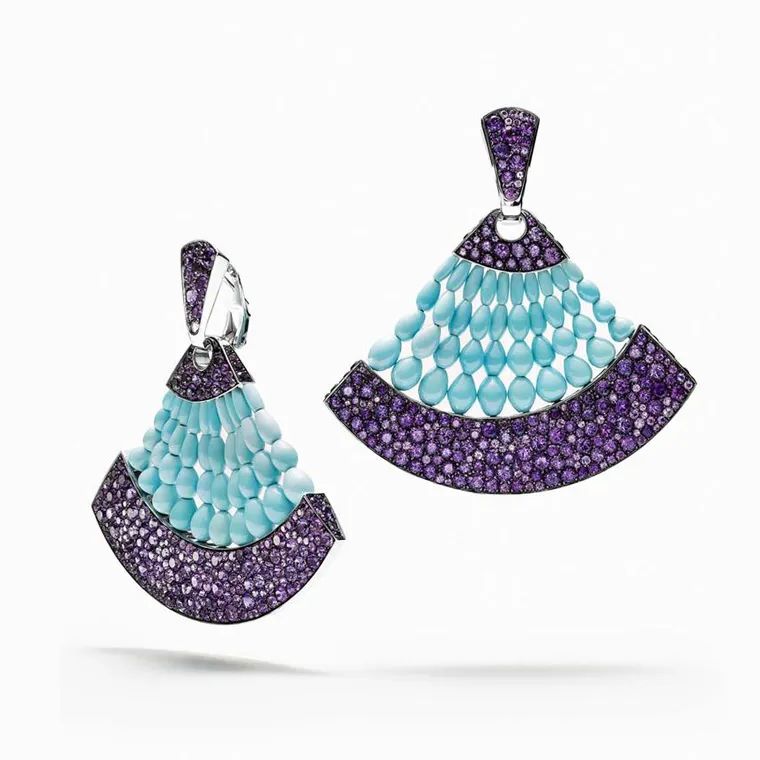
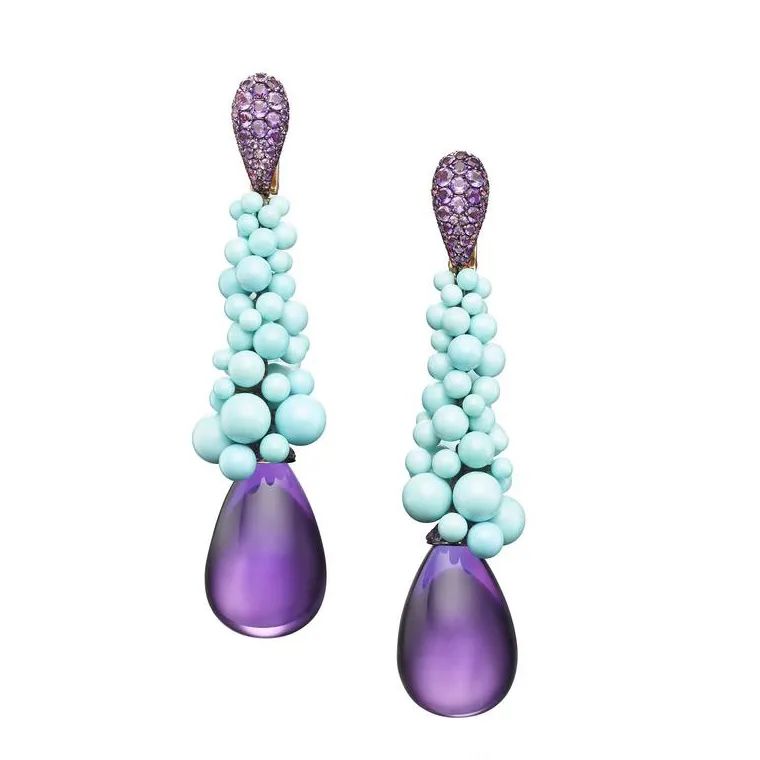

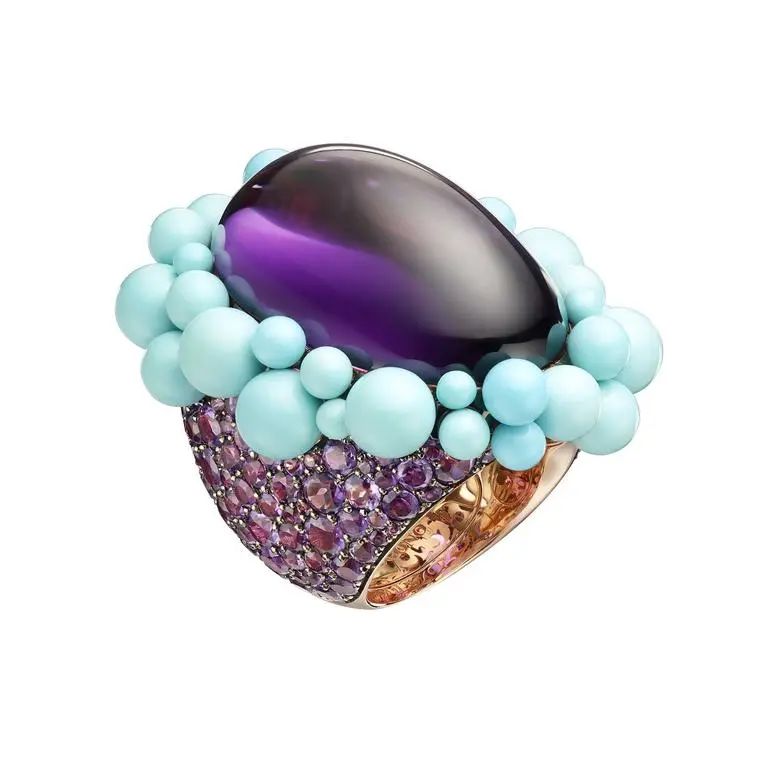
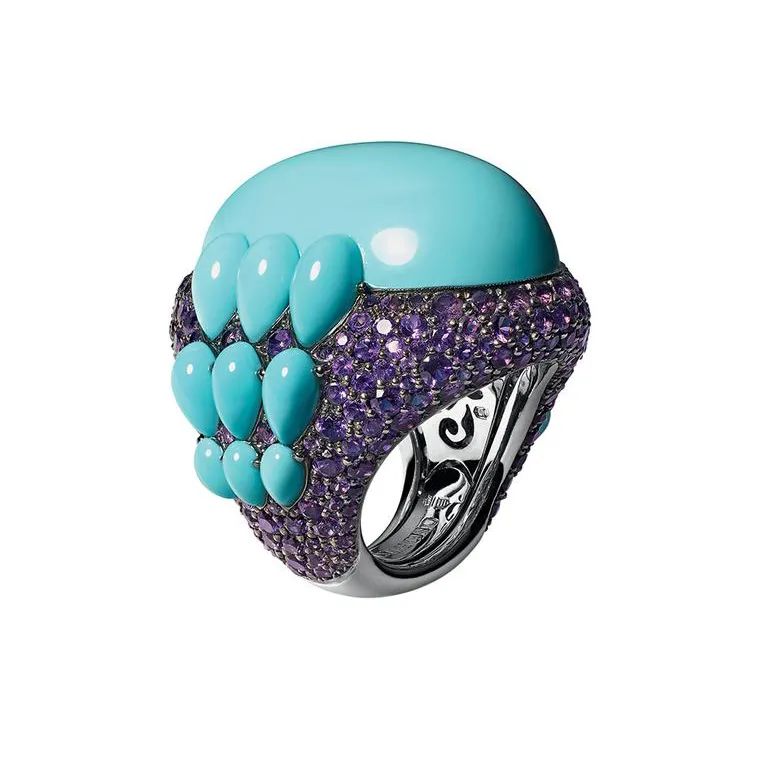
Melody of Colors Jewelry Series
18K rose gold, amethyst, turquoise
Boghossian jewelry, on the other hand, focuses on its expertise in setting techniques. Transparent and opaque gemstones are directly connected without metal settings, giving a seamless appearance.
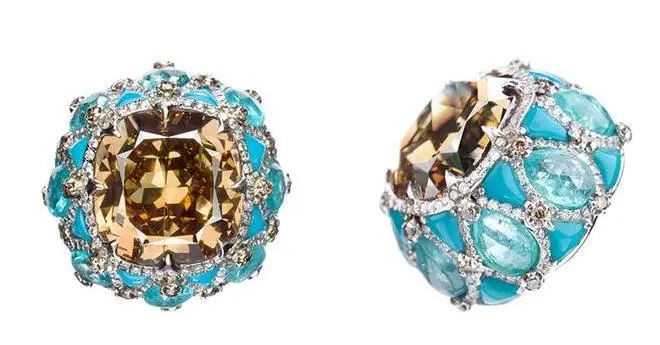
Champagne diamonds, turquoise, Paraiba tourmaline
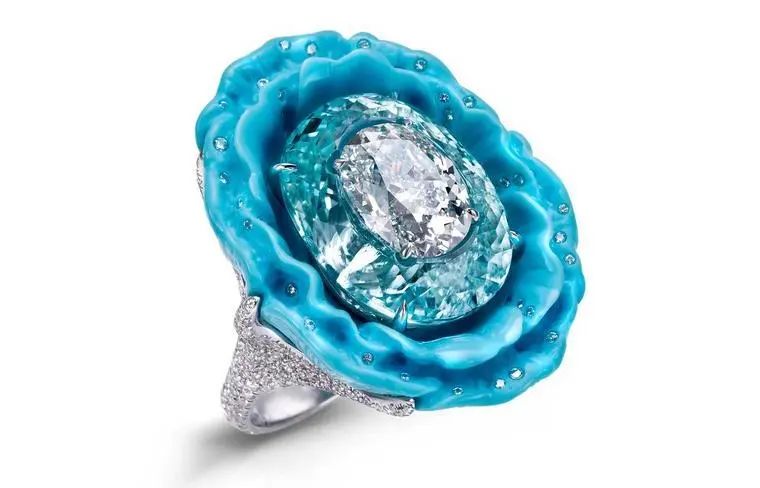
Hand-carved turquoise, Paraiba tourmaline, diamonds
Turquoise is a gemstone full of lucky energy
Of course, in everyday jewelry, turquoise is also a highly favored gemstone because it represents luck and healing energy in both Eastern and Western cultures. Many designers value its auspicious meaning and vibrant color, each with their own set of “interpretive” theories.
Jacquie Aiche, a jewelry designer from California, is particularly fond of turquoise, as it is also a favorite among Native Americans in the Western United States. Her jewelry brand is known for its rugged, natural, and free-spirited hippie style, attracting many young fans. She calls her “followers” the “JA Tribe.”
Therefore, her works emphasize the natural beauty of turquoise, expressing naturalism and the spirit of freedom.
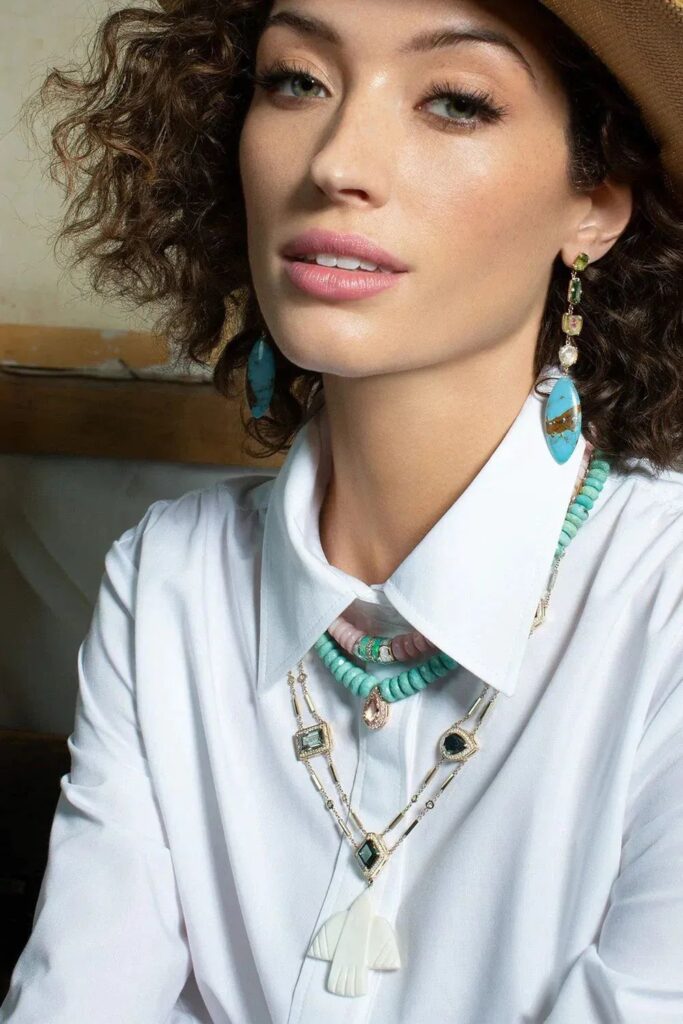
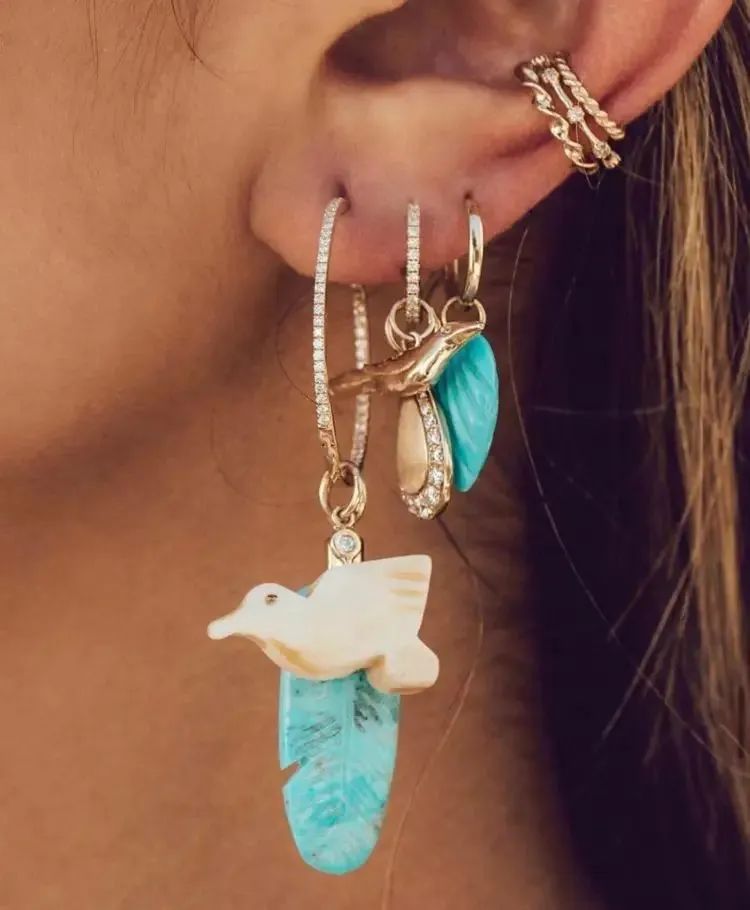
Canadian designer John Hardy discovered the raw charm of traditional handmade jewelry during his travels to Bali. In his Cinta series, the featured Bamboo Ayung necklace uses turquoise as the main stone, incorporating nearly 600 carats of high-quality Sleeping Beauty turquoise that is no longer in production.
He combines these soft, delicate blue turquoises with champagne diamonds, topaz, tsavorite, and Paraiba tourmaline. At first glance, it appears to have a rugged ethnic style, but it’s actually full of intricate details, with each bead perfectly showcasing its unique charm.
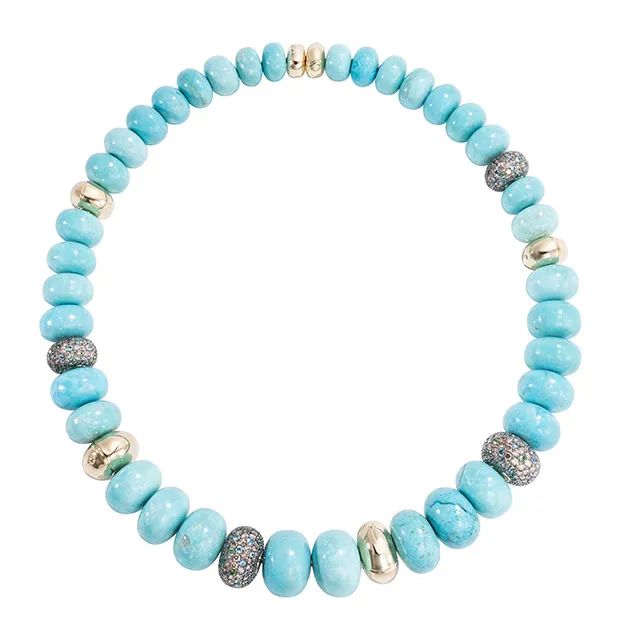
Cinta Bamboo Ayung Necklace
18K yellow gold, Sleeping Beauty turquoise, diamonds, topaz, tsavorite, Paraiba tourmaline
Some designers combine turquoise’s blessings and healing energy with lucky charms. For example, Sorellina, famous for designing jewelry tarot cards, combines turquoise with tarot cards and traditional lucky symbols like crescents and evil eyes, giving the wearer an extra “luck buff.”
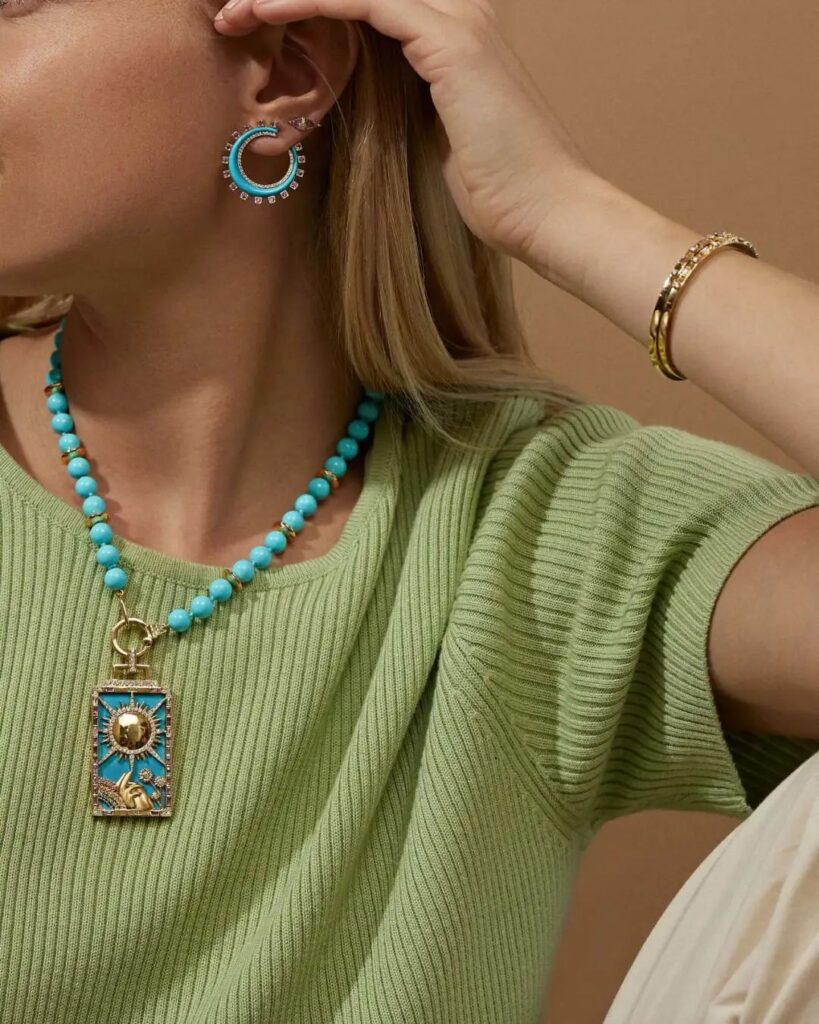
18K gold, turquoise, diamonds
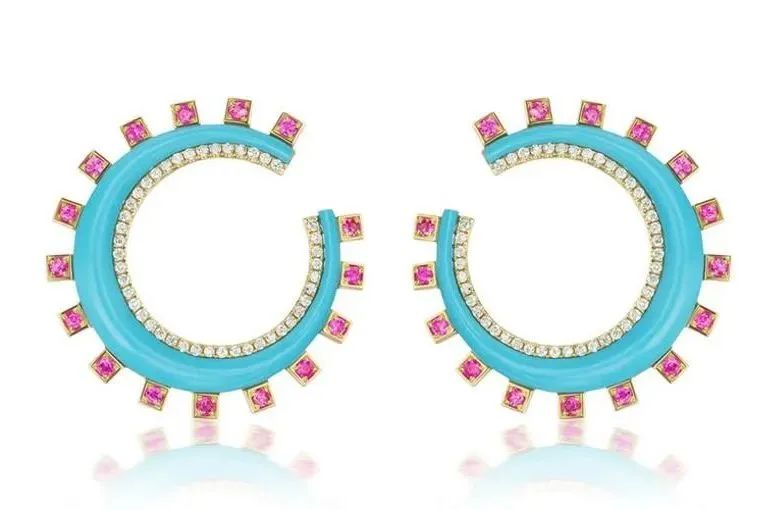
18K gold, turquoise, sapphire, diamonds
Emily P Wheeler, known for her colorful jewelry, couldn’t miss out on the vibrant turquoise. Her Chubby rings are made with hand-carved turquoise from Arizona, inlaid with a light green chrysoberyl or a pink spinel, and surrounded by enamel or diamonds, creating a striking contrast in texture and color.

Chubby Ring
18K yellow gold, white gold, turquoise, diamonds, chrysoberyl
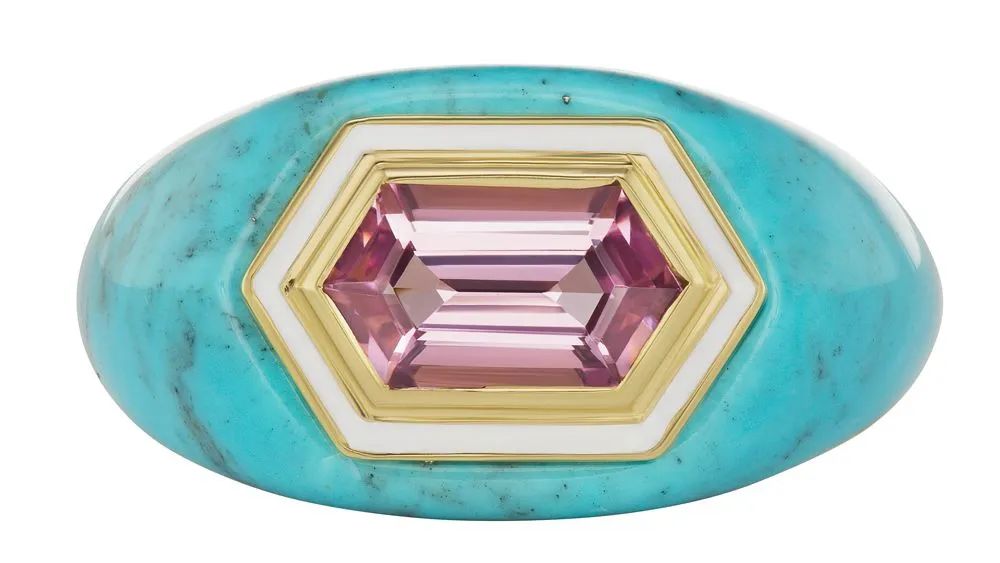
Chubby Ring
18K yellow gold, turquoise, spinel, enamel
Who wouldn’t love a turquoise bracelet?
For us “children of the Celestial Empire” who have been working with turquoise since prehistoric times, the charm of turquoise has been deeply rooted in our bloodline. Passed down to today, young people still have a deep love for turquoise bracelets. However, there’s quite a bit of depth to this, and some industry terms should be clarified first. There are also some pitfalls to be careful of.
Let’s clarify these industry terms first:
Raw ore: Raw ore refers to naturally mined stones that have not undergone any artificial processing such as resin injection or dyeing.
High porcelain: This refers to turquoise with high porcelain quality, presenting a smooth, glazed surface like porcelain.
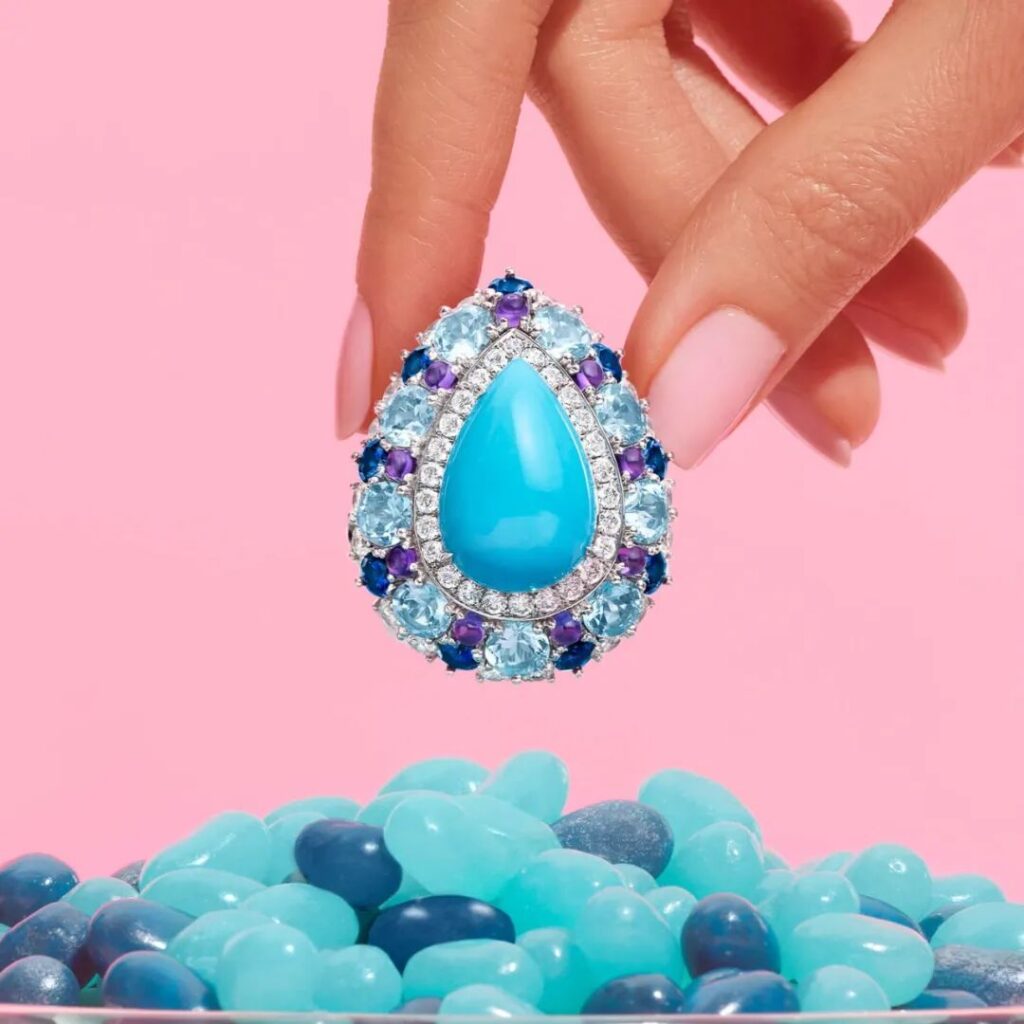
Candy High Jewelry Collection Ring
Turquoise, amethyst, diamonds, aquamarine, sapphire
Porcelain grade: This directly indicates the density of turquoise. Lower density turquoise is referred to by enthusiasts as “bubble turquoise,” which can easily become dirty after handling if the density is very low.
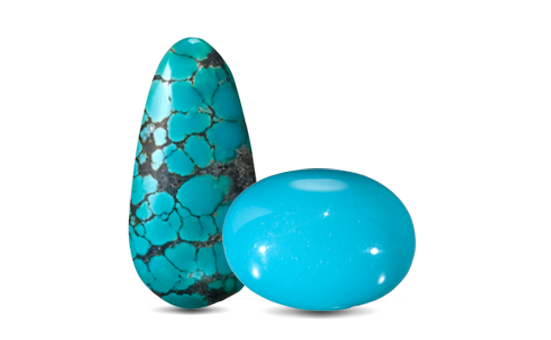
Jadeization: This usually refers to turquoise that has nearly reached the quality of precious jade. Under slightly strong light, the product will show transparency throughout (high jadeization) or have a translucent effect on the edge close to the light (medium jadeization), presenting an effect similar to jadeite green, which looks very beautiful.
Iron lines: Fine veins of black limonite distributed in a web-like pattern within the turquoise, creating various natural patterns such as black tortoise shell, web, or vein-like patterns. These fine black limonite veins are called iron lines, which are hard in texture and firmly bonded with the turquoise.
Pitfalls to avoid:
Due to turquoise’s popularity, there are many counterfeiting methods. The editor first emphasizes the importance of checking certificates, especially when purchasing high-quality turquoise. Nothing is more reliable than a certification from an authoritative institution! After all, counterfeiting techniques are constantly evolving, making it difficult to guard against.
Less than 5% of mined turquoise can reach gemstone quality without any modification, meaning 95% of natural production is not suitable for jewelry making. People naturally don’t want to waste these materials, so about 98% of turquoise on the market has undergone some treatment, including impregnation or stabilization, dyeing, and the proprietary Zachery treatment.
Therefore, be cautious if you encounter turquoise with very uniform color. Natural turquoise can only achieve completely uniform color, no iron lines, and high porcelain grade with high quality, which may only be seen in high-end jewelry or antique pieces.
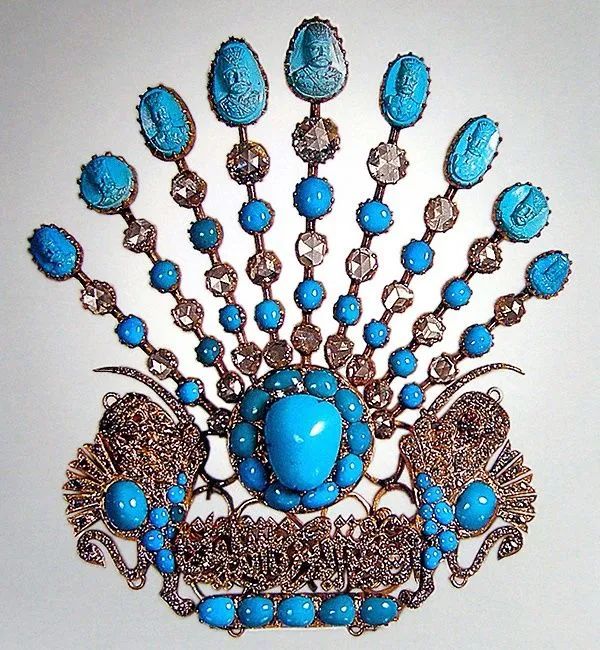
Thus, this level of color uniformity might be achieved through dyeing during impregnation treatment, or it could be synthetic gemstones. After all, technology in the 1970s could easily simulate the appearance of rare Sleeping Beauty turquoise, with differences only detectable under a microscope.
Yes, apart from a small amount of high-quality turquoise, almost all turquoise undergoes impregnation treatment (also known as stabilization). In this process, turquoise is immersed in a substance to improve its durability and color. Like oiling emeralds, this treatment is accepted by the market, but sellers should clearly disclose it.
More deceptive practices include dyeing other materials to imitate turquoise, such as hemimorphite or magnesite, or even glass. Also, don’t believe claims that low porcelain grade turquoise can become high grade or even achieve a jade-like effect through handling, as human sweat and oil cannot change the density of turquoise.
Many low-quality turquoises passed off as high-quality are indistinguishable to the naked eye. Therefore, it’s strongly recommended to check certificates, especially for various precious turquoises like Persian Blue, Sleeping Beauty, Wulan Flower, or Canary Yellow. Be extremely cautious when purchasing.

Bracelet set with ancient Egyptian turquoise
From Ancient Egypt to Modern Haute Joaillerie: The Timeless Allure of Turquoise
Tweet
